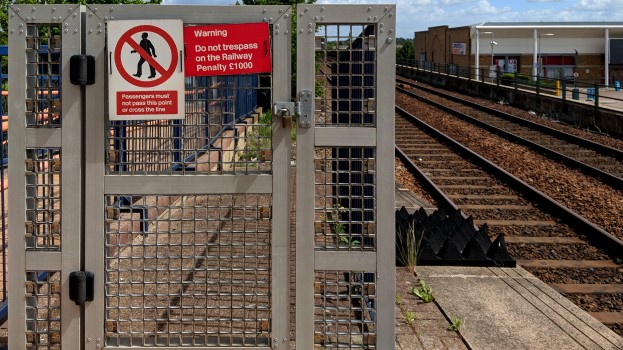Railway trespass incidents occur most in summer, but whatever the season, stay alert to trespass and raise your concerns.
Here are just some of the concerns about trespass we've taken forward and what happened next.

Above: trespass prevention measures at a station
Trespass incidents on the railway occur most during the British summer time, says Network Rail's You vs Train campaign. It can almost double compared to the winter months. Schools are out, people are out and about – perhaps on holiday in new locations – and there is a higher likelihood of risk-taking behaviour.
Whatever the season, stay alert. Trespassing on the railway is illegal and dangerous, so if you become aware of a trespass incident, you can report it to the British Transport Police on 0800 40 50 40 or 999 or by texting 61016. This is immediate and will help with identifying trespassers.
Trespass can damage a site or equipment – including through theft – but may also have the potential to cause injury or death to the trespasser or others. Other consequences include delays.
There may be ways your employer would prefer you to report trespass incidents internally. Ask them for details.
However, if you would prefer to raise it confidentially, you can report it to CIRAS (transport and infrastructure's confidential reporting service). We will listen to your concern and pass it on without revealing your identity.
Most trespass reports to CIRAS this year have been about access to rail infrastructure, but reports can also be about unauthorised access to buildings or work sites.
We take concerns about anything that might encourage trespassing – from a hole in a fence near the railway, to an unsecured access point, or anti-trespass mitigations not being effective because of poor maintenance or people regularly forgetting to close or lock a door.
These real-life case studies show how speaking up to CIRAS about trespass has helped to identify locations and encourage more preventative measures.
New hotspot flagged
People were trespassing on the track at Lelant station on the St Ives branch in Cornwall. At the south end of the platform, a user-operated crossing provides a way to cross safely. People were crossing at the other end – where there is no authorised crossing – to get to the side of a river estuary. The reporter asked Network Rail to install a barrier at this end and an anti-trespass pad between the end of this and the platform edge, and to add signage.
It had not been a high-priority location because there hadn't been reports of trespass here, so the report flagged this new location. After a site visit, a visible camera was installed along with signage – several trespass incidents have since been captured on it. Since the report, new fencing has been installed, a public engagement day has been held at the station with the police, and Network Rail's safety education partner has been tasked with contacting local schools to explain why trespassing is so dangerous.
Fencing fixed
A bridge in an area of Glasgow had been a target of graffiti for years. A reporter to CIRAS suspected it was accessed through the palisade fence or the station platform. They wanted the trespass prevention measures at this location to be reviewed.
As a result, a full review of the trackside bridge area was carried out with the British Transport Police, who then increased their patrols. The boundary fencing was fixed, and a request submitted to extend the fence and add more fencing. Longer-term prevention work included local community engagement and speaking with graffiti artists locally to encourage the community to keep graffiti to pre-determined, safe locations.
Gate design reconsidered
A gate to a platform from a car park at Leeds station wasn't closing automatically because it was faulty, and staff were not always closing it behind them, leaving the location vulnerable to trespass. The reporter said that graffiti on a stabled train showed that people were trespassing.
The report resulted in new signage and a briefing to staff about the importance of closing the gate. The concern was highlighted to station security staff. A project team was also tasked with looking at how to make the gate close more easily, such as a more lightweight gate or a strong hydraulic arm.
Report your health, safety or wellbeing concern now
Find out more
Case study: anti-trespass measures put in place
Tags
- Infrastructure Issue
- Infrastructure Managers
